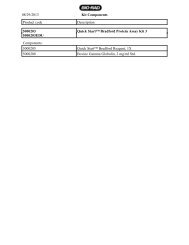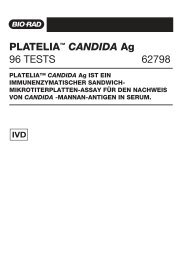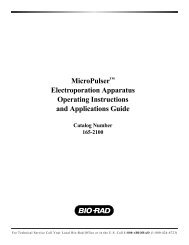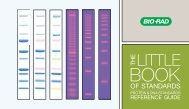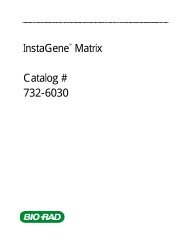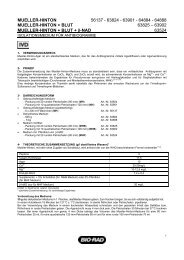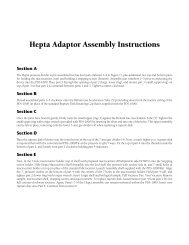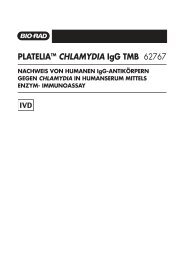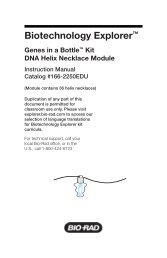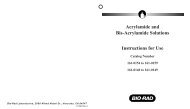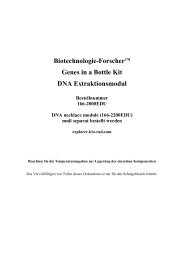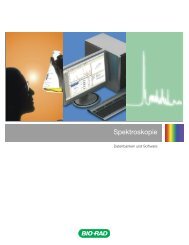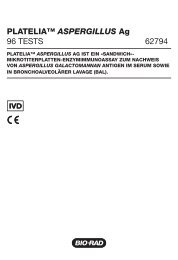Protein Expression and Purification Series - Bio-Rad
Protein Expression and Purification Series - Bio-Rad
Protein Expression and Purification Series - Bio-Rad
Create successful ePaper yourself
Turn your PDF publications into a flip-book with our unique Google optimized e-Paper software.
CHAPTER 3B<br />
ADVANCE PREP<br />
INSTRUMENTATION PROCES<br />
<strong>Protein</strong> <strong>Expression</strong> <strong>and</strong> <strong>Purification</strong> <strong>Series</strong><br />
Allow the LB agar to cool so that the outside of the flask is just comfortable to hold (around 55°C). A<br />
water bath set at 55°C is useful for this step. Be careful not to let the agar cool so much that it begins<br />
to solidify. Solidified agar can be reheated to melt if antibiotics have not been added.<br />
B. While the agar is cooling, label the plates LB/amp. Label the outside of the lower plate rather than<br />
the lid of the plates that are to be prepared.<br />
C. Ensure LB agar is cooled to 55°C before adding ampicillin since excessive heat will degrade the<br />
ampicillin. Add 200 µl of 50 mg/ml ampicillin to the molten LB agar. The final concentration of the<br />
ampicillin in the LB/amp agar plates will be 50 µg/ml. Swirl or use the stir bar <strong>and</strong> a stir plate to mix the<br />
ampicillin into the agar taking care not to introduce bubbles.<br />
D. Pour the LB/amp agar plates. One LB/amp plate is required for each team.<br />
Figure 3B.2. Preparation of LB/amp agar plates.<br />
E. After the plates have dried at room temperature for two days they should be stored at 4°C enclosed<br />
in plastic bags or plastic wrap to prevent the plates from drying out. Plates are good for two months.<br />
Pour excess agar in the garbage, not in the sink. Wipe any agar drips off the sides of the plates.<br />
3. Prepare LB broth: At least two days prior to cell culturing, prepare four Erlenmeyer flasks with<br />
100 ml of LB broth: to each of four 500 ml Erlenmeyer flasks, add 100 ml of distilled water <strong>and</strong> 2<br />
capsules of LB broth. Prepare one Erlenmeyer flask with 200 ml of LB broth: to a 1 L Erlenmeyer<br />
flask, add 200 ml of distilled water <strong>and</strong> 4 capsules of LB broth. Heat the solutions until the capsules<br />
dissolve. Autoclave all five flasks on wet cycle for 30 minutes. Allow the broth to cool to room<br />
temperature before use.<br />
Note: LB broth without ampicillin is used to rehydrate the BL21(DE3) with pDHFR bacteria.<br />
If an autoclave is not available, LB broth can be filter sterilized through a 0.2 µm filter into a sterile<br />
container, or it can be sterilized in the microwave by heating to boiling at least three times. (Note:<br />
reduce evaporation by using a lower power setting on the microwave so the solution simmers rather<br />
than boils.) Storage of LB broth at 4°C is recommended <strong>and</strong> can be stored for up to one year. LB<br />
broth can also be stored at room temperature if desired; however, this is not recommended if the<br />
microwave or filter sterilization methods have been used for sterilization, or if the bottle has been<br />
opened after sterilization.<br />
4. Rehydrate bacteria: Using a sterile pipet, rehydrate the lyophilized E. coli BL21(DE3) containing<br />
pDHFR by adding 250 µl of LB broth directly to the vial. Recap the vial <strong>and</strong> allow the cell suspension<br />
to st<strong>and</strong> at room temperature for 5 minutes. Store the rehydrated bacteria at 4°C until used (within 24<br />
hours for best results).<br />
5. Set up student workstations according to the student workstation list on page 76.<br />
74 Chapter 3B: Advance Preparation for<br />
Chromatography Instrumentation Protocols



